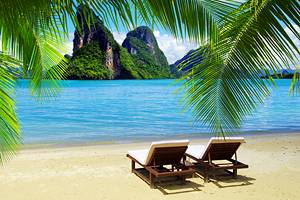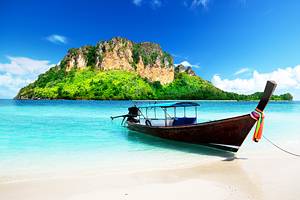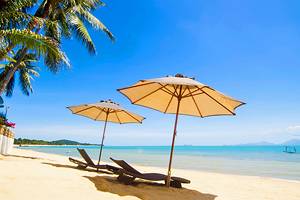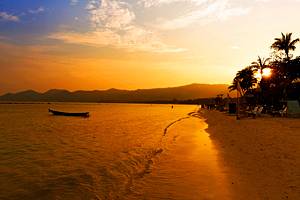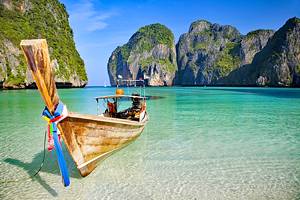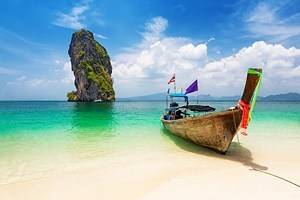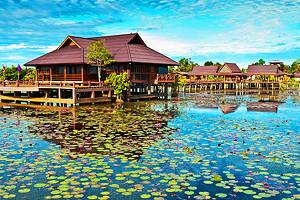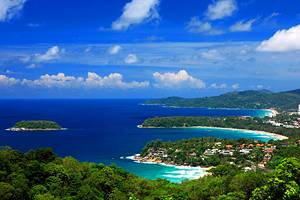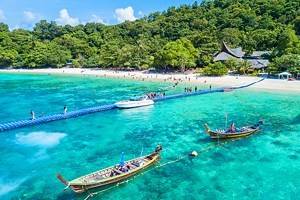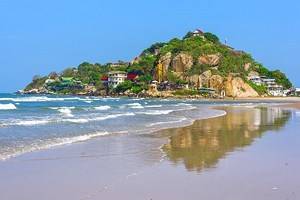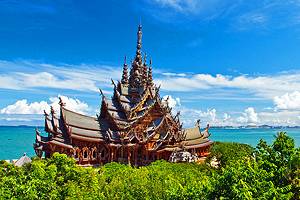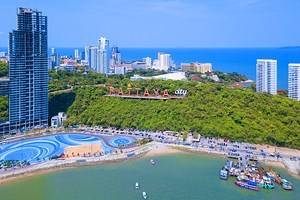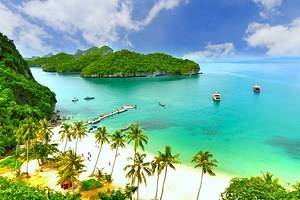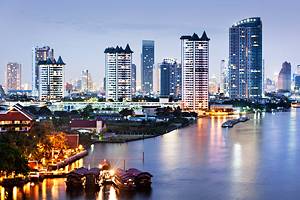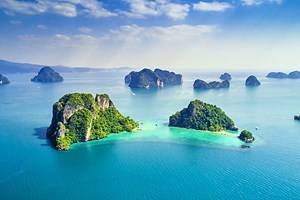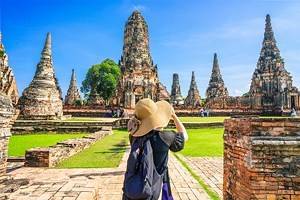Attractions & Things to Do in Koh Samui
Koh Samui is the largest island in the Gulf of Thailand, followed by its two smaller "sisters": Koh Phangan and Koh Tao. Diving, snorkeling, swimming, and basking on the picturesque jungle-backed beaches are popular things to do here, as well as boat tours around the sublime seascape of Ang Thong National Marine Park.
Because Koh Samui is the only of the three "sisters" with an airport, most tourists arriving from Bangkok or abroad land here. Regular ferries run between all three islands, however, for example, the trip between Koh Samui and Koh Phangan takes only half an hour, making it easy to island hop and see all the sights.
For ideas on how to spend your time and what to do when visiting the island, see our list of things to do in Koh Samui.
- Sunbathe and Swim at Koh Samui Beaches
- Take a Boat to Koh Phangan
- Tour Ang Thong National Marine Park
- Hop Over to Ko Tao for Diving and Snorkeling
- Head to Sail Rock for Even More Diving
- Discover the Secret Buddha Garden
- Explore Phra Yai Temple Complex
- Stop by Wat Plai Laem
- Kayak in Koh Taen
- Eat and Shop at Fisherman's Village Bophut
- Go Rock Climbing at Chaweng and Lamai Beaches
- Trek to See Some Waterfalls
- Explore Maenam's Chinatown
- Scoot around the Island
- Discover Wat Na Phra Lan
- Visit Nathon Town
- Drive to Wat Phra Chedi Laem
- Marvel at Khao Hua Jook Chedi
- Hike Elephant Rock
- Visit the Lamai Sunday Night Market
- Map of Attractions & Things to Do in Koh Samui
- Best Time of Year to Visit Koh Samui
Sunbathe and Swim at Koh Samui Beaches
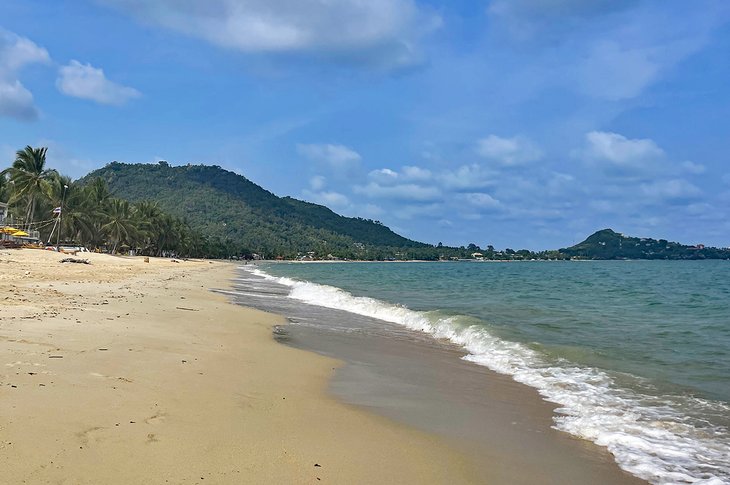
Koh Samui's beaches provide variety and serenity in equal parts. Chaweng Beach is one of the most popular on the island and the most developed. It's home to a number of luxury resorts. Chaweng Noi, to the south, is one of the beaches in Thailand.
On the less developed southeast coast lies Laem Setbeach. This peaceful, palm-fringed slice of paradise has a beautiful coral garden off the coast and unusual rock formations. To catch the sunset, head northwest to Phang Kabeach for a spectacular view.
At Lamai Beach, Koh Samui's second largest resort area, look for the distinctive rock formations colorfully described as "Grandpa" (Hin Ta) and "Grandma" (Hin Yai), referring to the anatomical likeness to their names. You can stay right on the beach here at four-star and five-star resorts.
Northeast of here, Silver Beach (Haad Thong Ta-khian) is a picturesque, palm-lined cove flanked by smooth granite boulders, with great snorkeling in the calm bay.

On the north side of the island, peaceful Maenam Beach offers views of Koh Phangan. You'll find an appealing range of accommodations here, from affordable backpacker bungalows to mid-range boutique hotels, and five-star resorts.
Take a Boat to Koh Phangan

Just a stone's throw (in fact, you can see one island from the other's shore) is Koh Phangan, the second largest of the three islands and one of the most popular day trips from Koh Samui. Koh Phangan's coast is more rugged than Koh Samui, with huge granite rocks and jungle-cloaked mountains rising behind the beaches. Most of the development clusters along the south and west coasts.
Unlike the many wide stretches of flat beach along Koh Samui, Koh Phangan's coastline tends to scallop into sheltered coves, flanked by outcroppings of granite and backed by lush hills. On the island's relatively quiet east coast, Thong Nai Pan Noi and Thong Nai Pan Yai are among the most popular beaches-Noi in particular tends to be cleaner and has plenty of food stalls. Accommodation options here range from budget resortfour- and five-star resorts.
On the island's northwest coast, Haad Yao, Hat Salad (Salad Beach), and Haad Son, also known as "Secret Beach," are great options, with decent snorkeling a short kick from shore. Accommodation options here are mainly budget and mid-range resorts.
Just to the south, Haad Chao Phao, about 30 minutes from the pier and main tourist area, provides a perfect balance of comfort and quiet, with several good restaurants and small seaside bungalow resorts. It's easy to find transportation to other parts of the island, but quiet enough that you feel you have a little piece of Phangan (almost) to yourself.
For a truly secluded experience, Bottle Beach (Hat Khuat) on the island's north coast is an excellent choice, but it's best accessed by a long-tail boat unless you don't mind a hike through the steamy jungle along a rutted dirt road. Accommodation here is fairly basic.
Tour Ang Thong National Marine Park
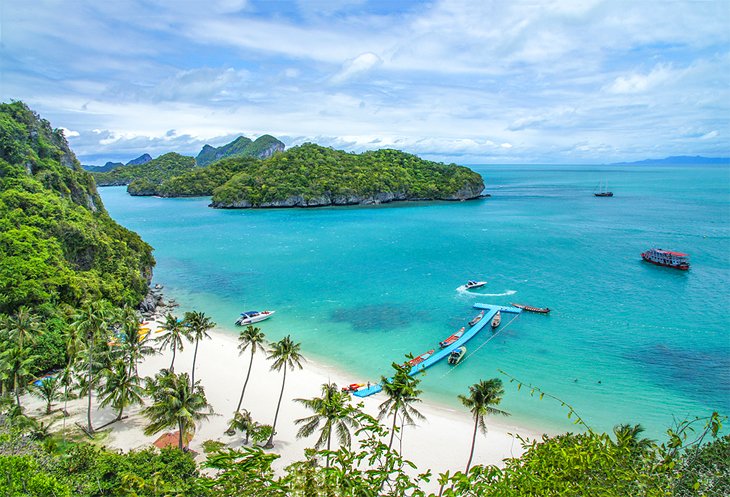
Both Koh Samui and Koh Phangan are part of this breathtaking archipelago of 42 islands. If you take only one tour while you're on vacation in this area, make it a sightseeing tour around Ang Thong. Many tour companies offer one-day packages, and you can typically arrange these through your hotel or guesthouse.
Most include a boat tour through the islands with stops for snorkeling, kayaking, and hiking to viewpoints, where you can admire this amazing island chain. Limited accommodation is available in the park, so plan your time well if you want to return to the main islands for the night. Be sure to keep your camera handy and find a spot above deck, because you won't want to miss the breathtaking photo ops.
Hop Over to Ko Tao for Diving and Snorkeling

From the air, Ko Tao (the smallest of the three islands) looks like mounds of granite boulders cloaked in green, drifting on a jade-green sea and linked by dazzling sweeps of white-sand beach. Diving is the most popular thing to do here. Colorful coral reefs lace the clear waters that are home to some of the best diving spots in Southeast Asia. Vast schools of fish, brightly-colored sea anemones, stingrays, and even whale sharks are among the sea creatures spotted here, and the island is a popular and relatively affordable place to obtain PADI scuba diving certification.
Though it's certainly no off-the-beaten-path destination, Koh Tao typically has less tourists than both Samui and Phangan. Accommodation consists mainly of villas and bungalows that peek out from the jungly slopes, with breathtaking views of the bay.
Head to Sail Rock for Even More Diving

Experienced divers will want to check out this popular diving site between Koh Tao and Koh Phangan, marked by a huge limestone rock jutting 10 meters out of the water. This famous wall dive, with a maximum depth of about 40 meters, is known for being one of the best areas in Thailand for swimming with a range of exotic fish, and even whale sharks if you're lucky.
You can also see giant black coral, moray eels, and large schools of fish, such as batfish, snapper, and trevally. Another feature is the vertical chimney swim-through. While popular with experienced divers, Sail Rock is actually suitable for all levels of divers, depending on conditions.
Discover the Secret Buddha Garden
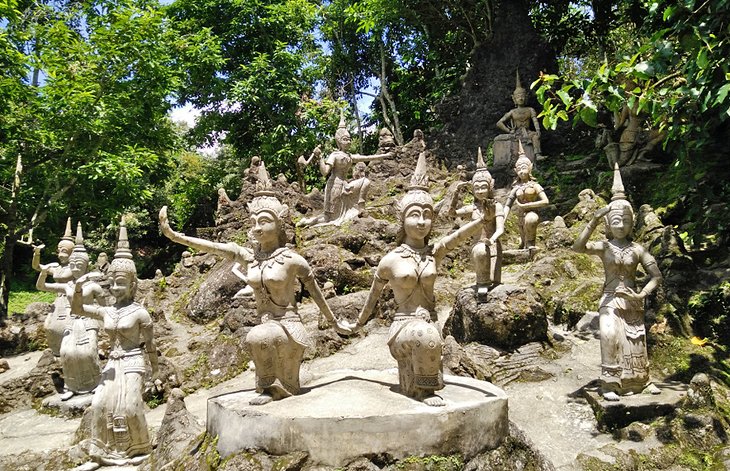
Set at the top of Pom Mountain, one of the highest hills in Koh Samui, the Secret Buddha Garden (AKA Tarnim Magic Garden) is a sculpture park worth a visit. Getting here requires a long and somewhat difficult climb, though, so be prepared for it.
The entire garden was the beloved project of Khun Nim, a retired farmer who worked on it for 14 years until his death at the age of 91.
He originally envisioned the place as an oasis to meditate and relax in solitude, but also as his final resting place one day. Over the years, however, he also added little houses with roofs covered in vegetation that traveling monks could use as a place to rest or meditate.
The final result is a magical place full of enclaves; fountains; and sculptures, including many Buddha statues in different poses, but also animals, angels, and musicians. There are even a couple of sculptures representing his parents, grandparents, and himself as a child. A short walk away, on a staircase path surrounded by a lush flowering garden, Nim's tomb offers the final peace he so eagerly wanted.
Explore Phra Yai Temple Complex
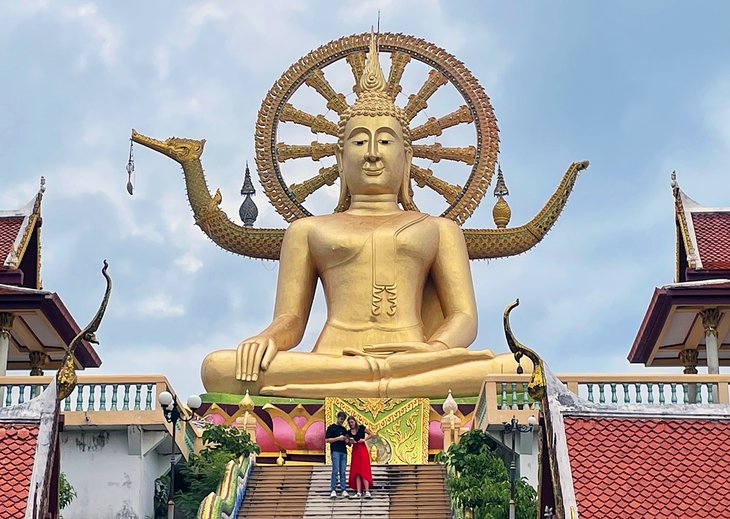
A somewhat majestic, somewhat overwhelming mix of reds and golds, this Buddhist temple is located in Ko Phan, less than three kilometers offshore from Koh Samui. Home to a massive 12-meter-high gold Buddha statue at the top of a staircase, Phra Yai (also known as the Big Buddha Temple) is one of the most popular temples in Koh Samui and a massive attraction for tourists year-round.
Aside from the main Buddha statue, there are also smaller statues here, as well as a collection of bells on the grounds of the temple.
Visitors who arrive in the early morning will be able to see local monks during their daily prayers. After a walk around the grounds, you can pick up some food or Buddhist statues and meditation supplies to take with you. Nearby Ang Thong National Marine Park and Wat Plai Lem are also worth a visit while you're here.
Stop by Wat Plai Laem
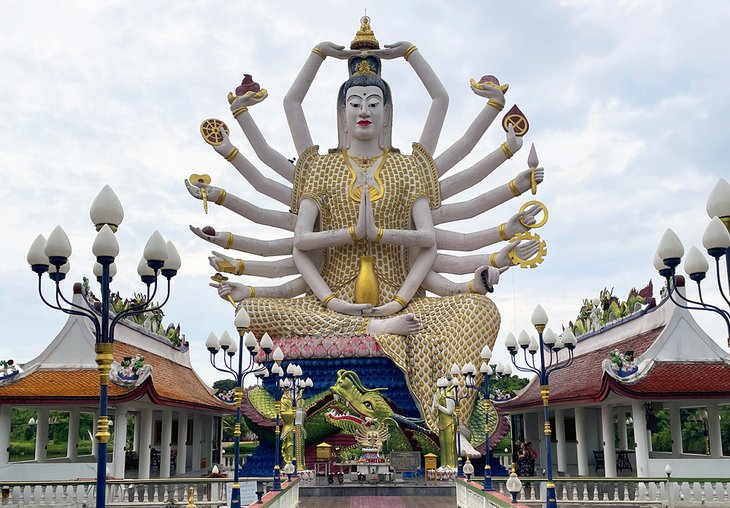
Wat Plai Laem is a Buddhist temple dedicated not to Buddha but to Guanyin (or Kuan Yin), the Chinese goddess of compassion and mercy. Although the temple is relatively new, it's been decorated using ancient techniques and murals.
Guanyin herself is depicted in her ancient form, as a massive gold and white statue with 18 arms. She's sitting on a platform-pavilion decorated with a large dragon, who is said to be able to carry the goddess to aid shipwrecked sailors. From here, she watches over the temple and a pond filled with fish-visitors who make a donation to the temple can grab a small bag of fish food in exchange.
On the other side of the temple complex, a giant laughing Buddha holding prayer beads presides over the ordination hall.
Kayak in Koh Taen
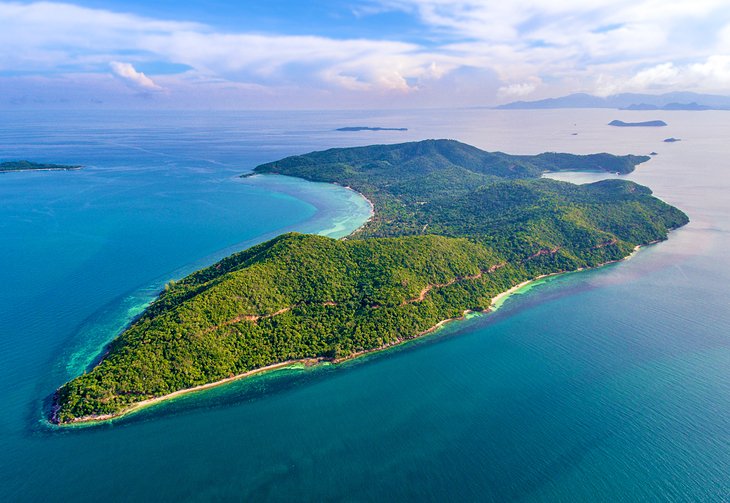
Koh Taen or Coral Island is located just five kilometers off the coast of Ko Samui. Technically part of the main archipelago, Koh Taen is only accessible by boat and rarely visited by tourists despite offering stunning coral reefs, great mountain biking trails, and a unique mangrove forest buzzing with local fauna. The island is also home to many monitor lizards, which can reach a size of up to 2.5 meters long, and a number of simple bungalows that can be rented for overnight stays.
Although Koh Taen has less than 50 permanent residents year-round, a number of companies offer day tours to the island for kayaking and snorkeling. Because of its location among other small archipelagos, the waters of Koh Taen are soft and calm and perfect for kayaking along the coastline.
Eat and Shop at Fisherman's Village Bophut
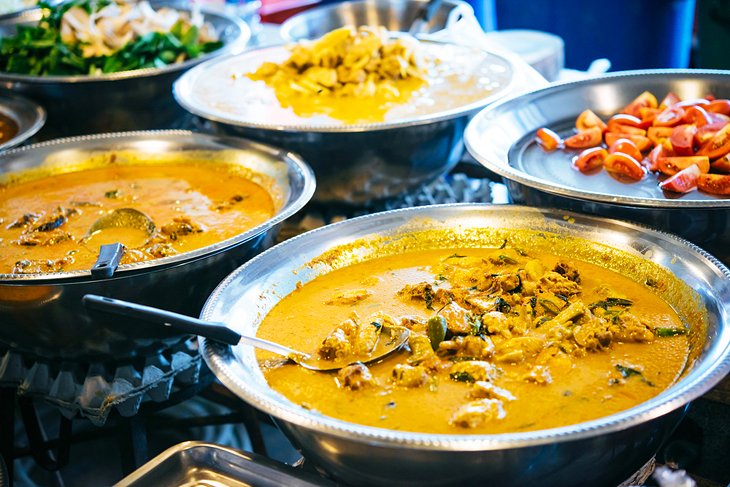
On the island's north coast, Bophut beach is right by the old Fisherman's Village, with its Chinese shophouses, funky boutiques, and popular night market. The Fisherman's Village Walking Street comes alive every Friday at 5pm – its sidewalks crammed with stalls, food vendors, and street performers.
While many night markets in Thailand focus mainly on cheap souvenirs and street food, Bophut offers a unique range of handicrafts, high-quality handmade jewelry, high-quality textiles, and even local spices and snacks.
Aside from shopping, this is a great place for local dining-both sitting down cafés and restaurants or food stalls where you can pick up a quick bowl of som tam or pad Thai to savor while you keep walking and exploring. Keep your eyes open for performances, too, once you reach the junction near the pier -traditional Thai dancers and Muay Thai fighters often put on short shows here that are full of color and charm.
Go Rock Climbing at Chaweng and Lamai Beaches
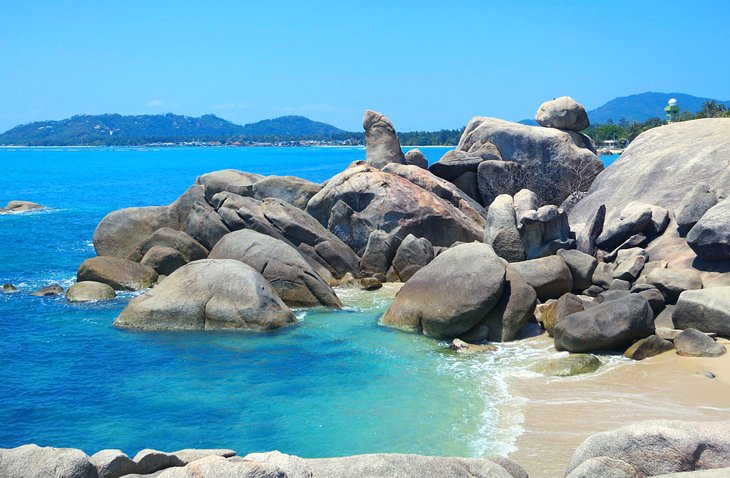
The stretch of coast near Koh Samui's most developed beaches has become a popular climbing and bouldering spot. With limestone walls up to 40 meters high and the promise of stunning views of the island's scenery from the top, both Chaweng and Lamai beaches offer great hot spots for rappelling and climbing. There are suitable routes here for both beginners and advanced climbers. Nearby Koh Tao island also has plenty of granite blocks, ideal for bouldering.
It's also possible to rock climb farther inland-but since much of the inland mountains can only be reached after a jungle trek, this option is best for experienced outdoor enthusiasts or those joining an organized climbing group. Day tours can be organized if you're a beginner or just want some help conquering the rocky formations.
Trek to See Some Waterfalls

There's a lot more to Koh Samui than white sandy beaches – just venture inland and away from the turquoise waters, and you'll discover a jungle paradise that's equally enchanting. If you're up for a slightly steamy but fascinating trek through a tropical forest, set off to find Koh Samui's three major waterfalls.
Na Muang 1 and Na Muang 2 (the "Purple Waterfalls") are located inside a park of the same name, which can be accessed by car. Na Muang 1 is close to the park's parking lot and easily accessible on foot; Na Muang 2 requires a steep but short trek uphill from the first waterfall. The first waterfall is the biggest and offers a small pool, perfect to cool down or for a swim.
Another waterfall worth a visit is Khun Si Waterfall. Located just a few minutes away from Khun Si viewpoint over Chaweng Beach, this waterfall is smaller and harder to find, but that means smaller crowds, and if you come in the morning, a good chance you'll have the waterfall all to yourself. Surrounded by thick lush jungle, this waterfall makes for a refreshing stop before you continue on to other attractions.
Explore Maenam's Chinatown
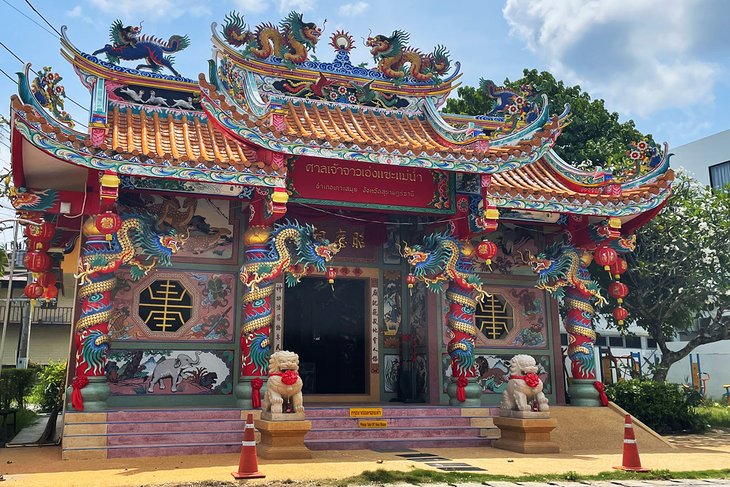
One of the best beaches in Koh Samui is Maenam Beach. Located on the northern shore of the island, about 15 minutes away from Choeng Mon, Maenam is a seven-kilometer stretch of soft, golden sand, gently lapping turquoise water, and views out to Koh Phangan. The vibe here is decidedly more laid-back, with more affordable bungalow-style hotels, a few high-end resorts, and quiet beach restaurants perfect for relaxing.
Maenam also happens to be the Chinatown of Koh Samui. You'll notice this immediately when you cross under the golden arch at the Walking Street. The small community has its own temple, as well, which is open for visiting. On Thursday evening, Maenam has its own Walking Street market.
While the neighborhood is much smaller than others on Koh Samui, the Walking Street is energetic, selling everything from fruits and flowers to leather, souvenirs, and street food.
Scoot around the Island

Koh Samui may be the second largest island in Thailand, but in reality it's not as big as you think. The island is only about 75 kilometers in circumference, meaning it's entirely possible to drive around it in a day. Renting a scooter or motorbike is incredibly easy in Thailand, and this is the best way to see Koh Samui.
The island has many different personalities, depending on which town you visit. Chaweng and Lamai have nonstop energy and are usually crammed with young tourists, while areas on the northern and western coasts are far more relaxed, undeveloped, and laid-back.
The interior of Koh Samui has a spine of rolling, jungle-covered mountains, which contain secrets like gorgeous hiking trails, waterfalls, and sculpture gardens. By driving around Koh Samui, you can experience many different atmospheres and personalities all in a single day.
Try to plan your scooter adventure early on in the trip, so you can discover which areas you may want to spend time in. Koh Samui always has something unique to discover, no matter which area you are in.
Discover Wat Na Phra Lan

Koh Samui has many temples that tend to take the spotlight. But a little digging off the beaten path will reveal many, many other temples on this island where visitors may feel like they have the entire complexes to themselves.
Welcome to Wat Na Phra Lan. Located near Maenam's pier, this small but gorgeous temple is certainly worth a stop. The temple is decorated in the traditional Thai Buddhist style with its gold and red colors, and is known for its statue of King Rama V.
The temple complex is very quiet, but has plenty of images of Buddha to admire. It is the perfect place to reflect quietly, far away from the busyness along the coast of the island.
Visit Nathon Town
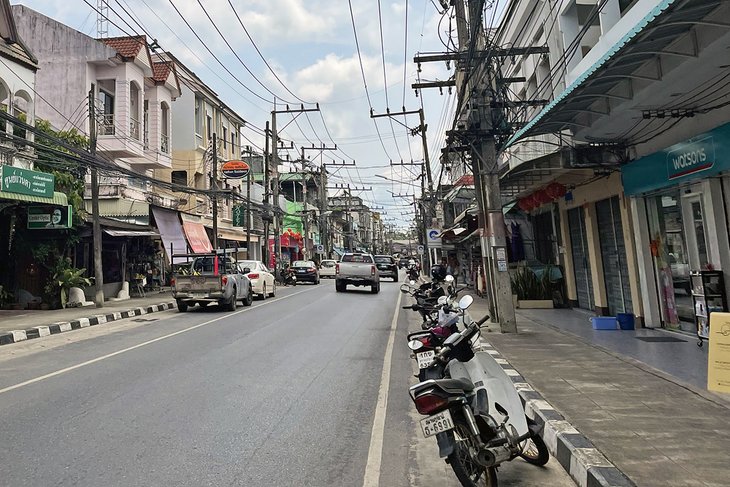
If you're arriving to Koh Samui by boat, then you'll be arriving in Nathon, the capital of Koh Samui. Most travelers hop off the ferry and find their transfers to their hotels, but the capital is a place that is worthy of a visit on its own.
Nathon isn't exactly on the tourist trail – it's on the western side of the island about halfway down, while all the hotels and restaurants start on the very opposite side of the island. But its lack of tourist infrastructure is exactly why it is worth a visit. Here is where you will see how life actually operates on Koh Samui, away from the infinity pool, pizza restaurants, and Jet Skis.
Take a stroll down the many side streets off the main road to take a look into the shops. The waterfront has plenty of dining options, though the ones closer to the ferry terminal are geared more toward tourists.
On Saturday evenings, Nathon hosts a walking street market, where the seafront area comes alive with vendors selling street food, clothing, and souvenirs.
Drive to Wat Phra Chedi Laem
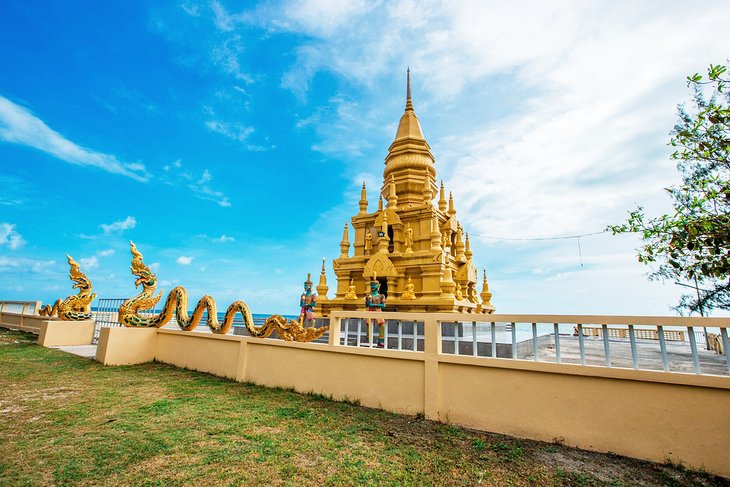
At the Southwest corner of Koh Samui sits a quiet stretch of beach on which is a gorgeous, golden pagoda. Wat Phra Chedi Laem feels like a world away from the swirling chaos of the east coast. Guarded by two statues, the structure radiates a quiet power. It is a lovely spot, where residents come to pray and enjoy the peace and quiet of the natural beauty of its surroundings.
Marvel at Khao Hua Jook Chedi
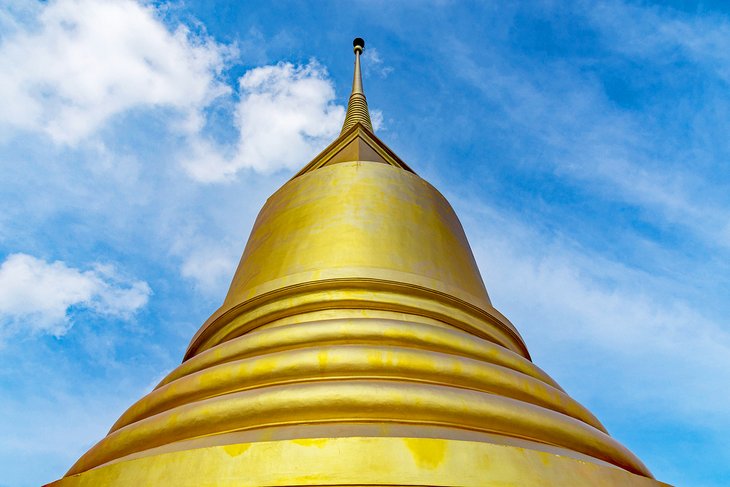
Up in the hills beyond Chaweng, you may notice the glimmer of a golden pavilion. This is Khao Hua Cook Chedi, one of the many temples on Koh Samui. The gleaming gold pagoda overlooks the beautiful beaches of the island from its hilltop perch. Visitors who come to visit the Chedi will have uninterrupted views over practically the entire island.
The Chedi is easy to get to via motorbike or taxi. From the parking area, steps lead to the top of the hill where the chedi sits. It's a peaceful overlook and a wonderful place for meditation, or to simply snap 360-degree panoramic pictures over Koh Samui.
Hike Elephant Rock
It doesn't actually look like an elephant, but Elephant Rock gets its name from its sheer size. This massive boulder marks the point of a beautiful hiking area, at the top of which is a stunning view of the sea. Elephant Rock is close to both Chaweng and Lamai, which means it's easy for most travelers to access.
Visit the Lamai Sunday Night Market
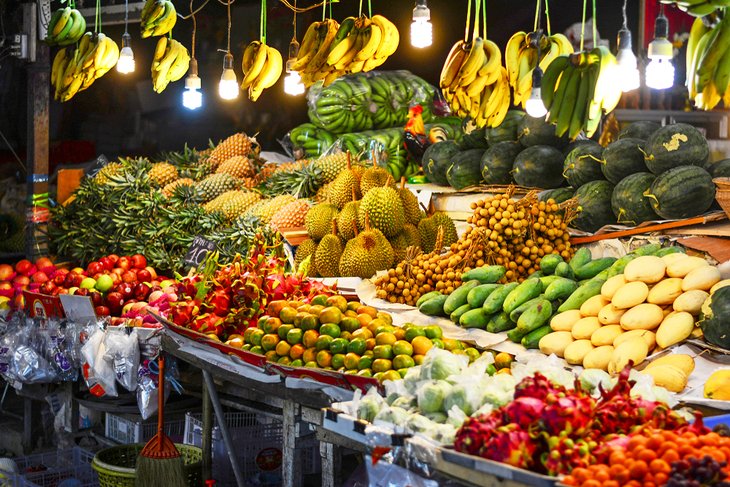
If you hit one night market on Koh Samui, better make it the Lamai Sunday Night Market. This weekly event happens in the heart of Lamai with two intersecting streets. One serves Asian food, and the other serves European-style food. Where the streets intersect, you'll find live music and entertainment.
It's a wonderfully buzzy (and busy) weekly event that brings people from all over the island – and all over the world – to enjoy one of the best sections of Koh Samui. Prices are beyond reasonable – you can eat a full meal and barely make a dent in your wallet, so this is a perfect spot to hit if you are traveling Thailand on a budget.
Map of Attractions & Things to Do in Koh Samui
Best Time of Year to Visit Koh Samui
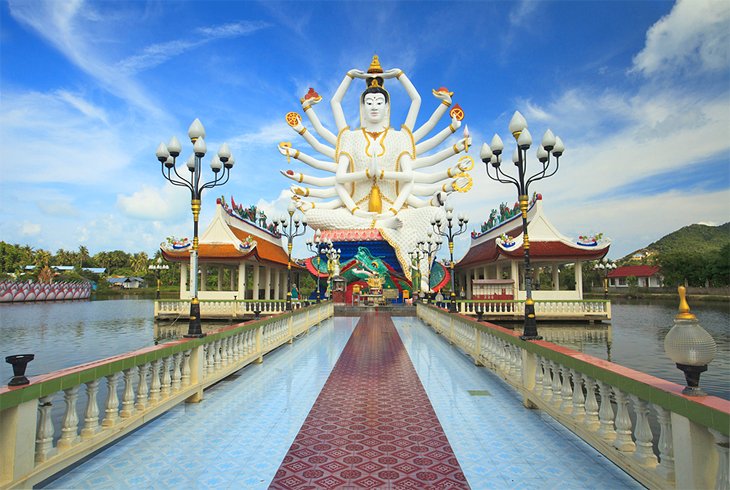
Koh Samui, as with most places in southern Thailand, has two seasons – dry and wet. Koh Samui also has different weather patterns than the islands on the other side of the coast, so just because it's a good time to visit Phuket and Krabi does not mean it's the best time of year to visit Koh Samui.
If you want sunshine and pleasantly warm weather, the best time to visit Koh Samui is from December to February, which is the dry season. But dry season, understandably, is also high season, so it will also be busy during this time. That said, you won't see any rain. If you want to jump into the sea, explore the surrounding islands, or get on a boat for a tour, this is definitely the best time of the year to visit.
If you have a budget in mind and want to avoid the crowds, then you might want to arrive during the hot or the rainy season, which chases many visitors away but offers better prices and better deals.
More Related Articles on PlanetWare.com
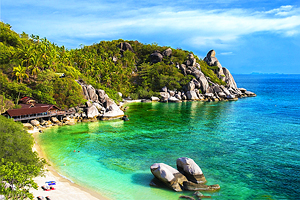
Exploring Southern Thailand: Koh Samui and its neighboring sister islands are home to some of the best beaches in the world. Whether you're looking for white sand and crystal-clear waters or an active holiday, you can find that in our list of picks for the Beaches in Thailand. Arriving in Koh Samui from Bangkok? Take a look at some of the best ways to make the trip on our article, From Bangkok to Koh Samui: 4 Ways to Get There.


